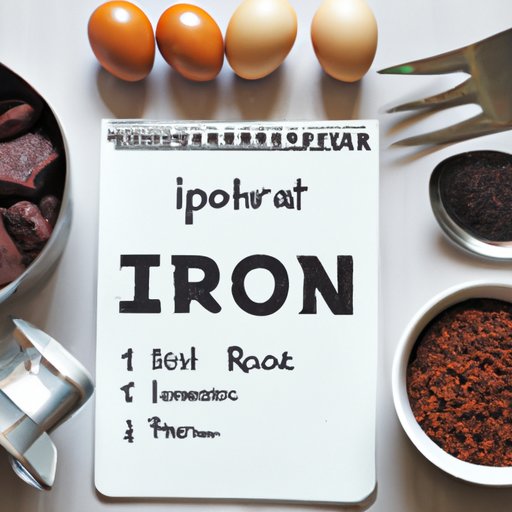
How to Get More Iron: A Comprehensive Guide
Iron is an important nutrient that plays a crucial role in the human body. It helps in the formation of healthy red blood cells, which carry oxygen to different parts of the body. Iron is also essential for proper functioning of the immune system and cognitive development. However, iron deficiency is one of the most common nutrient deficiencies, affecting millions of people worldwide. In this article, we provide you with a comprehensive guide on how to get more iron through food sources, meal planning, iron supplements, cooking methods, and lifestyle tips.
Food Sources
One of the primary ways to increase iron intake is by consuming iron-rich foods. Here are some foods that are high in iron:
– Red meat (beef, pork, and lamb)
– Poultry (chicken, turkey)
– Seafood (oysters, clams, sardines, tuna, salmon)
– Legumes (lentils, chickpeas, kidney beans, black beans)
– Tofu
– Spinach and other leafy greens
– Pumpkin seeds
– Quinoa
– Dark chocolate
It’s important to note that the body absorbs heme iron (found in animal-based foods) more efficiently than non-heme iron (found in plant-based foods). However, vegetarians and vegans can still get enough iron through plant-based sources, as long as they consume a variety of iron-rich foods regularly.
The recommended daily intake of iron varies depending on age and gender. For adult men and postmenopausal women, the recommended intake is 8 milligrams (mg) per day, while premenopausal women need around 18 mg per day. Pregnant women need even more – around 27 mg per day.
To increase iron intake, try to include at least one iron-rich food in each meal. For example, you can have a spinach omelette for breakfast, lentil soup for lunch, and grilled salmon with roasted veggies for dinner. You can also add iron-rich ingredients to smoothies or salads.
Meal Planning
Meal planning is a great way to ensure that you are getting enough iron in your diet. Here’s a sample meal plan for a day that provides more than the daily recommended intake of iron:
– Breakfast: Spinach and mushroom omelette with whole-grain toast (6mg iron)
– Snack: Apple slices with almond butter (1mg iron)
– Lunch: Lentil salad with roasted beets, red onion, and feta cheese (6mg iron)
– Snack: Greek yogurt with blueberries and pumpkin seeds (2mg iron)
– Dinner: Grilled salmon with quinoa and roasted veggies (4mg iron)
Recipe Suggestions for Iron-Rich Meals
– Beef and broccoli stir-fry: Cook 8 oz of beef with broccoli, onions, and garlic. Serve over brown rice or quinoa.
– Spinach and lentil soup: Sauté onions, carrots, and celery in olive oil. Add lentils, canned tomatoes, and vegetable broth. When the lentils are cooked, add fresh spinach and cook until wilted.
– Tuna and white bean salad: Mix canned tuna, white beans, cherry tomatoes, red onion, and parsley. Drizzle with olive oil and lemon juice.
– Grilled chicken with sweet potatoes: Marinate chicken breasts in a mixture of olive oil, lemon juice, and garlic. Grill and serve with roasted sweet potatoes.
Iron Supplements
If you are unable to get enough iron from your diet alone, you may consider taking iron supplements. There are two types of iron supplements – ferrous and ferric. Ferrous iron is more easily absorbed by the body and is available over-the-counter in tablet or liquid form. Ferric iron is only available by prescription.
It’s important to avoid taking iron supplements without consulting a healthcare professional first, as excessive iron intake can cause serious health problems. The recommended dosage varies depending on individual needs, and there can be potential side effects such as constipation and nausea.
Iron supplements are generally recommended for those who have a diagnosed iron deficiency or are at risk for deficiency, such as pregnant women and those with heavy menstrual bleeding.
Cooking Methods
The way you cook your food can affect the amount of iron you absorb. Here are some tips to help you preserve iron when cooking:
– Use cast-iron cookware: Cooking with cast-iron skillets can increase the iron content in your food.
– Avoid overcooking: Overcooking can destroy the iron content in food. Cook vegetables until they are al dente (soft, but still retaining their shape).
– Consume vitamin C: Consuming vitamin-C rich foods (such as citrus fruits or bell peppers) can help increase iron absorption.
Lifestyle Tips
There are also lifestyle changes you can make to increase your iron absorption and reduce iron loss. Here are a few tips:
– Avoid drinking tea or coffee with meals: The tannins in these drinks can inhibit iron absorption.
– Increase vitamin A intake: Vitamin A helps the body absorb iron more efficiently. Foods high in vitamin A include sweet potatoes, carrots, and dark leafy greens.
– Avoid excessive alcohol intake: Alcohol can inhibit iron absorption and increase iron loss through urine.
– Exercise regularly: Regular exercise can increase blood flow and help the body absorb nutrients more effectively.
Conclusion
In conclusion, getting enough iron is crucial for overall health and wellbeing. By incorporating iron-rich foods in your diet and following these tips on meal planning, cooking methods, and lifestyle changes, you can ensure that you are getting enough of this essential nutrient. If you are still unable to get enough iron from your diet, consult a healthcare professional to assess whether iron supplements may be necessary. Remember, small changes can make a big impact on your health.




